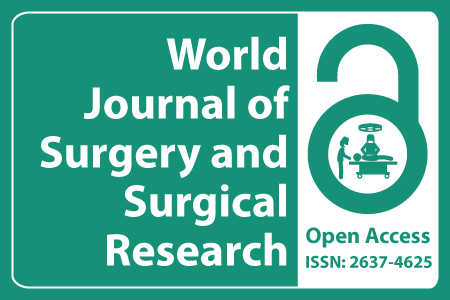
Journal Basic Info
- Impact Factor: 1.989**
- H-Index: 6
- ISSN: 2637-4625
- DOI: 10.25107/2637-4625
Major Scope
- Ophthalmology
- Cardiothoracic Surgery
- Breast Surgery
- Gynecological Surgery
- Plastic Surgery
- Surgical Oncology
- Surgical Procedures
- General Surgery
Abstract
Citation: World J Surg Surg Res. 2022;5(1):1396.DOI: 10.25107/2637-4625.1396
Rapid Detection of Internal Transcribed Spacer 1 Region of Opisthorchis viverrini from Bile Samples in Patients with Cholangiocarcinoma by Loop-Mediated Isothermal Amplification Method
Meemo S, Lek-Uthai U, Leelawat K, Kampeera J and Kiatpathomchai W
Program in Infectious Diseases and Epidemiology, Mahidol University, Thailand Department of Parasitology and Entomology, Public Health, Mahidol University, Thailand Department of General Surgery, Rajavithi Hospital, Thailand CENTEX Shrimp, Mahidol University, Thailand National Center for Genetic Engineering and Biotechnology (BIOTEC), Thailand
*Correspondance to: Lek-Uthai U
PDF Full Text Research Article | Open Access
Abstract:
Opisthorchiasis caused by Opisthorchis viverrini is an important fish-borne zoonotic trematode in Southeast Asia. In Thailand, it was found that liver fluke infection is a major cause of Cholangiocarcinoma (CCA). The bile samples were collected from 21 patients with cholangiocarcinoma during June 2014 to February 2015 at the Department of Surgery, Rajavithi Hospital, Bangkok. The internal transcribed spacer 1 of Opisthorchis viverrini (OV ITS1-DNA) in bile sample detected by Conventional PCR method showed 5 positive (23.8%) while LAMP and Real-Time PCR methods were 9 positive (42.86%) and 14 positive (66.67%) detected, respectively. In the present study was to detect OV ITS1-DNA by Loop-Mediated Isothermal Amplification (LAMP) methods combined a portable Real-Amp turbidimetric end-point detection method byproduct: Magnesium Pyrophosphate (Mg2P2O7). The LAMP amplification can be finished in 60 min under isothermal conditions at 63°C in 37 min by employing a set of five species-specific primer mixtures. The results can be checked by naked-eye visualization and 2% agarose gel electrophoresis. The result of lower limit of OV ITS1-DNA detection by naked-eye visualization and 2% agarose gel electrophoresis indicated that the former was able to detect OV ITS1-DNA dilutions up to 2 pg, which it was approximately 10 times more sensitive than 20 pg conventional PCR method. LAMP, Conventional PCR, and Real-time PCR methods were able to detect O. viverrine. DNA at a lower level of 1 pg/μL, 10 pg/μL and 100 fg/μL, respectively. The LAMP assay was highly sensitive, and turbidity assay process less than 1 h. A portable turbidimetric system could be easily used at field site. This result may be useful for future research in the detection of O. viverrini in bile samples of CCA patients to determine the factors of the causative agent related to CCA with an effective laboratory method.
Keywords:
Loop-mediated isothermal amplification; LAMP; Turbidity; Opisthorchis viverrini
Cite the Article:
Meemo S, Lek-Uthai U, Leelawat K, Kampeera J, Kiatpathomchai W. Rapid Detection of Internal Transcribed Spacer 1 Region of Opisthorchis viverrini from Bile Samples in Patients with Cholangiocarcinoma by Loop- Mediated Isothermal Amplification Method. World J Surg Surgical Res. 2022; 5: 1396..













